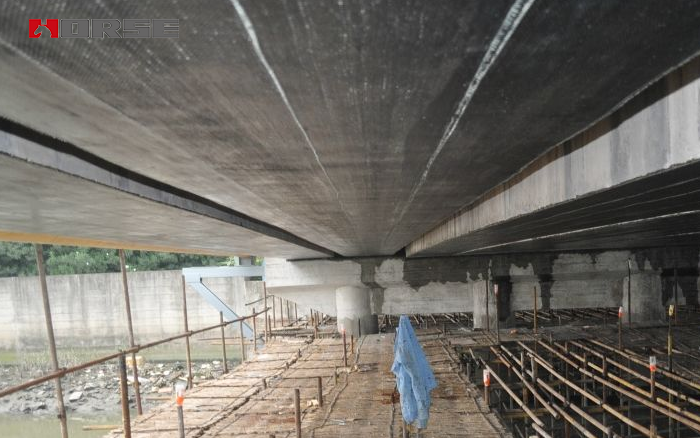CFRP reinforced concrete beam bridge
Bridges retrofitting
CFRP and reinforcing bar bear the load together, reducing the stress of reinforcing bar, so that the structure has achieved the effect of strengthening and reinforcing. It is believed that carbon fiber reinforcement will become the inevitable trend of bridge reinforcement in the future.

Principle of CFRP Reinforced Concrete Structure: When a special resin is used to bond carbon fiber fabric to the tensile surface of concrete structure, carbon fiber fabric and the original structure form a new stress entirety. CFRP and reinforcing bar bear the load together, reducing the stress of reinforcing bar, so that the structure has achieved the effect of strengthening and reinforcing.
The main features of bonding carbon fiber reinforcement technology are:
The structure weight and section size are hardly increased.
Does not change clearance height under bridge;
Easy to construct;
Almost no damage to the original structure.
It has good corrosion resistance, durability and fatigue resistance.
Excellent mechanical properties, can be effectively used for a variety of structural reinforcement, including bending, shear, compression, fatigue, seismic, wind resistance, crack control and deflection expansion, increase the ductility of the structure, according to the analysis of the force can be multi-layer bonding reinforcement, its direction can also be flexible grasp.
In addition, carbon fiber texture is soft, can not change the shape of the structure under the premise of strengthening a variety of concrete structures, after strengthening can be coated with concrete mortar, or the pattern requires painting a variety of pigments, repair and reinforcement without leaving traces.
Methods of strengthening and strengthening with CFRP sheets:
Flexural reinforcement, carbon fiber sheet attached to the tensile side;
The shear reinforcement can be done by vertically pasting on both sides of the beam or by forming U-shaped ring wrap on the bottom, which is equivalent to increasing the shear stirrups.
Crack resistance is strengthened and pasted along the vertical direction of cracks.
The column core compression member is reinforced and the central ring of the column is bonded.
The shear wall is strengthened, and the carbon fiber sheets are pasted along the shear walls one or both sides along the shear reinforcement.
The effect of carbon fiber reinforcement is remarkable, but the following problems should be noticed in actual bridge reinforcement works. Carbon fiber environment and construction conditions are very different from the laboratory, and the construction performance of the material itself affects the quality of construction, so the design tensile strength of carbon fiber should be considerably reduced from the laboratory data. The technological level of the construction team is also a factor affecting the mechanical properties of composite materials, but it is not yet quantitative evaluation. At present, it is scientific and reasonable to define the influencing factors on the design strength of carbon fiber by the method of partial coefficient, but the specific values of these factors should be determined according to a large number of experimental data and scientific theoretical analysis.
Conclusion
Through the continuous study of carbon fiber materials and continuous improvement of carbon fiber reinforcement methods, it is believed that carbon fiber reinforcement will become the inevitable trend of bridge reinforcement in the future.